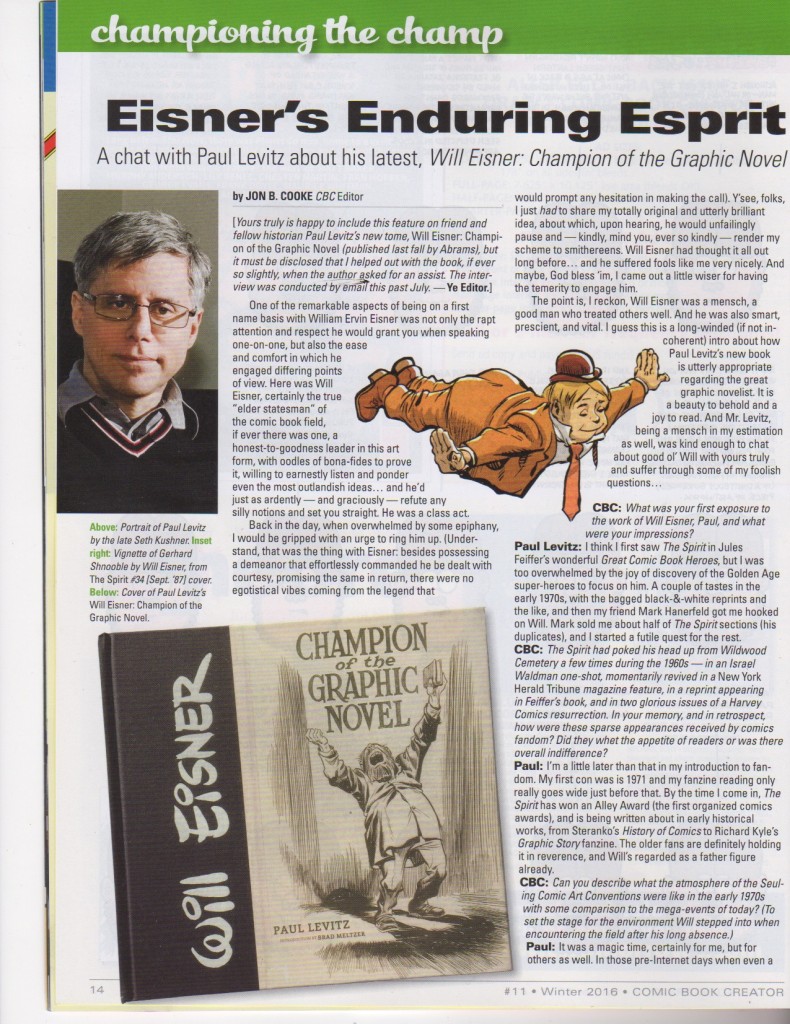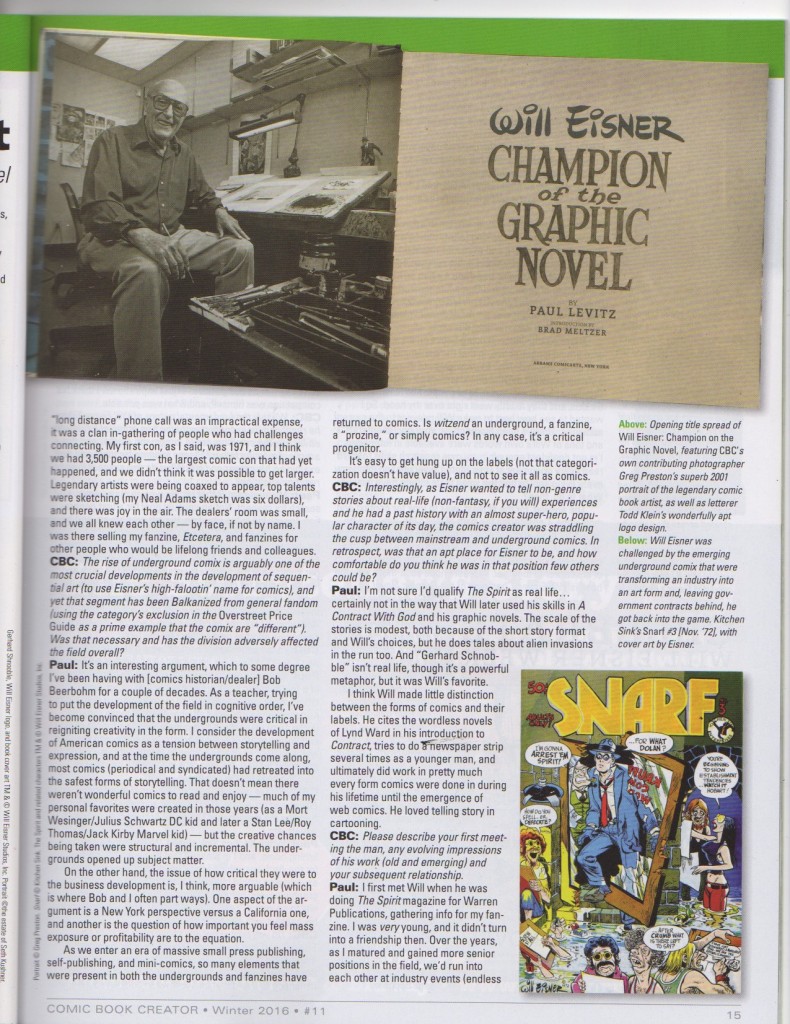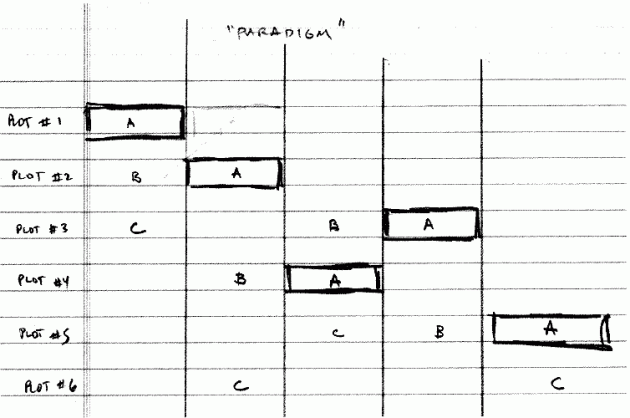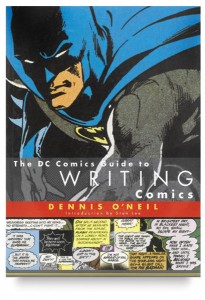Jon B. Cooke interviewed me for an article in the latest issue of Comic Book Creator!
If your local retailer doesn’t carry this cool magazine, you can buy a copy HERE.


Jon B. Cooke interviewed me for an article in the latest issue of Comic Book Creator!
If your local retailer doesn’t carry this cool magazine, you can buy a copy HERE.


Just a redirect here, reminding folks I have a new column up at icV2.com about comics retailing.
http://icv2.com/articles/columns/view/33836/facing-graphic-novel-era
Forty years ago, DC Comics held its one and only Super DC Convention, and we gathered together the greats of the Golden Age for what was the last time. Jerry Siegel and Joe Shuster had just reached the final accommodation of their lives with DC, and were there smiling, along with Bob Kane, Shelly Mayer, Jack Schiff and many others. The then-still active team that was present included Julie Schwartz, Murray Boltinoff, Sol Harrison, Joe Orlando, Jack Adler, Joe Kubert, Curt Swan, Denny O’Neil, and the youngsters like me. Jenette Kahn had just arrived at DC a few weeks before, and the chaos that was the convention provided her first great bonding with the small team that was then the DC staff of about 30 folks. Virtually everyone who was invited attended, with the notable exception of Bob Kanigher, who was nervous to be on the Wonder Woman panel with his old boss, Shelly Mayer.
Chaos? The convention had been scheduled to be at the Commodore (later the Grand Hyatt) Hotel, but they had gone on strike two days before. Hasty arrangements were made to shift to the Americana (now the Sheraton NY Times Square), and I have a vague memory of our needing to carry over a certified check for the deposit because Warner Communications/DC Comics’ credit wasn’t enough to satisfy them in the circumstances. DC folks were on phones trying to get radio stations to announce the new location, and we ended up rolling giant mail bins full of stuff for the con down 52nd Street from the offices to the hotel.
February 29th was Superman’s birthday under Nelson Bridwell’s analysis, so the official peak of the con was a giant birthday cake made of Twinkies (a major advertiser in comics in those days). There were leftover Twinkies to eat at the office for a long time. But the real thrill was meeting the men who had created the world of comics and super heroes, and for most of us, for the first or only time.
Somewhere in DC’s files there are grainy old videotapes of some of the panels, magic moments when the greats of the Golden and Silver Age of Comics met. Maybe technology has reached the point where they can been enhanced, and we can revisit that moment…
A tip of the hat to the departed Phil Seuling and Sol Harrison, who cooked up the event, and to my fellow “manager,” Jonni Levas (who as always, organized Phil) and the other Junior Woodchucks, whose love of comics showed through it all.
Smiling at the new DEATHSTROKE #15 variant cover by Neal Adams. My inner comic fan was always tickled to be in the comics, going all the way back to a Gold Key issue of STAR TREK when Allan Asherman and I were written in as red shirts (and we all know what happens to them…). Showing up in stories I was connected to was nice but not surprising (the LEGION tabloid, the Wedding of Superman and Lois a generation later, with a few others in between). Being mentioned in the Marvel Bullpen Bulletins a couple of times was a special treat, as it crossed company lines. But covers are so rare. As best I can recall, the last time I made the cover was also by Neal — SUPERMAN VS. MUHAMMAD ALI with its amazing crowd scene. Thanks, Neal!
BTW, recalling the ALI cover brings to mind Carol Fein. Carol had been Carmine’s secretary before leaving to have her second daughter. I used to stand by her desk to read Jack Kirby’s Fourth World issues as they came in from the coast. She came back to DC shortly after Jenette Kahn arrived to assist Jenette when the secretary she inherited from Carmine was a bad fit. Carol became the company morale officer, with her booming boro accent (think Fran Drescher with less restraint), sexy sense of humor, and endless warmth. No one could make a bagel party come to life better than Carol. Anyway, Carol was responsible for chasing the paperwork permissions for each of the people on the ALI cover: celebrities, politicians, comics folks; and only the very rare person would say no to her. In mid-life she battled MS with enormous courage, and sadly we lost her way too soon. A lot of the people on the DEATHSTROKE cover shared smiling moments with Carol…
In my speech at Comics Pro this week I described the time we’re living in as the new Golden Age of Comics, and a more creative one than the first. Taking nothing away from the first generation of comics creators, including many who became my friends like Will Eisner, Shelly Mayer and Jack Kirby, to name three of the most influential, they were inventing a form with little to go on but the very short newspaper strip comics as a baseline. Today’s creators have a body of comics created over eight decades that they are using as a foundation for incredibly diverse and innovative work.
The diverse part is key, in my opinion. When you consider the success of manga as a form in Japan (where it’s about a third of publishing), part of it must come from the vast diversity of content offered in manga form. Fiction, history, how to, all for any possible audience. American comics (with perhaps a 4-5% share of the publishing market here) has operated in a very small creative range until the last decade or two. Now we’re seeing talented people speaking to a wider selection of subjects, and through that, a wider audience.
Much of the work is not to my personal taste, of course. As a reader, as well as a writer, certain subjects interest me and others don’t. And some subjects work better in prose than in comics (or vice versa). But as someone who has worked to expand the comics market in several different roles through my life, I’m thrilled to see the experimentation with subject matter, styles and formats…and even more excited to see the readers being attracted as a result.
And I really do think the best is yet to come.
There’s a new volume out updating an older collection of essays about Batman: MANY MORE LIVES OF BATMAN, edited by Roberta Pearson, William Uricchio and Will Booker (2016, British Film Institute). I’m pleased to say the lead essay is a piece of mine, “Man, Myth and Cultural Icon,” exploring why I think Batman has been the most protean of the great comic book heroes. He’s been successful (and perceived as ‘true’) in incarnations as different as the role played by Adam West and Christian Bale, as well as so many interesting comics incarnations. There are interesting essays by the editors and folks like Henry Jenkins, one of the academic founders of ‘transmedia’ as a subject. Check it out if you get a chance.
With art by Tim Hamilton
With art by Sonny Liew
Khalid’s quest for answers leads the young Doctor Fate to his ancestral homeland of Egypt, where he discovers that malevolent supernatural forces have conspired to make life a lot harder for humanity than it should be.
There’s been a bit of conversation lately about something Denny O’Neil kindly labeled “the Levitz paradigm” – a plotting tool I used in the Legion’s heyday to keep track of the many fluid plots and subplots. The physical ‘device’ is pretty simple, and the theory is one that was rapidly evolving in super hero comics in the ‘80s but which has deep roots in soap opera. Warren Ellis said some nice things about it recently online, and I wanted to both point out its prior ancestry and my modest contributions.
Today the terms “A plot” and “B plot” are conversational language, but in the ‘80s that wasn’t the case. Stan Lee and Roy Thomas had been developing the tools in comics since about 1965, and Robert Altman had been weaving it in films, but it hit the broadest mass culture when it moved to network prime time with HILL STREET BLUES.
If the ‘paradigm’ was anything beyond a charting tool, it was a few (sometimes ignored by me, sadly) guidelines:

 And all of this is, of course, secondary to basic plotting rules like making stakes important to the characters, and flowing plots from the characters themselves. Or one that I’ve grown fonder of in my recent years of teaching, that what reveals/defines character is choices, particularly choices with costs.
And all of this is, of course, secondary to basic plotting rules like making stakes important to the characters, and flowing plots from the characters themselves. Or one that I’ve grown fonder of in my recent years of teaching, that what reveals/defines character is choices, particularly choices with costs.
It’s a fairly simple and useful charting tool for doing serial comics, and if you’re curious to look at it, check out Denny’s DC Guide to Writing Comics.
With art by Tim Hamilton